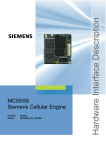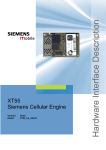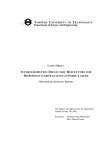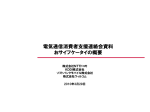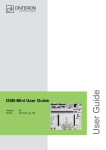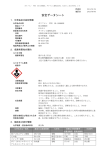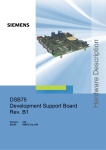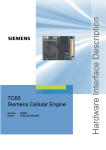Download TDC Development Support Board for Siemens Wireless Modules
Transcript
TDC Development Support Board for Siemens Wireless Modules Introduction The TDC Development Support Board (DSB) is intended to assist engineers and designers in developing and evaluating Siemens Wireless modules. The board supports a number of modules from Siemens, covering GSM, GPS, GPRS, EDGE and 3GSM (HSDPA) technologies. The board is available only as part of a kit (TDCDSB-NM-ISSUE-3), which includes: z Software, documentation & utilities CD z Plastic mounting feet (4) z G70 12V Power supply z G60-ML Mains cable z Antennas (1 x dual band whip, 1 x GSM/GPS combi) Please specify the module you need when ordering the development board kit. Although not currently illustrated, the board is supplied with a bracket that mounts on the two centre mounting holes, and carries a UFL to FME connector for GSM operation, and UFL to SMA for GPS. UNDER NO CONDITIONS MUST MORE THAN ONE MODULE BE FITTED at the same time. Damage will occur to both the modules and the board. The board will only support one module at a time. Last update - 17th April 2008 TDC Development Support Board for Siemens Wireless Modules Quickstart Not much to say here, apart from checking that the jumpers are fitted in accordance with the settings in the overview section for default operation. Make sure the board is on a clutter-free area so that the back of the board does not short out on anything and connect the serial cable to a suitable terminal or terminal emulation program. The recommended initial data rate is 115,200bps, N parity, eight data bits and 1 stop bit. Switch off hardware handshaking at this stage. Connect power and the serial cable to J5 (serial port 0). Switch on the unit by pressing the IGN switch for about a second - the Module OFF LED should switch off, and the SYNC LED should start flashing. You don't need a SIM fitted at this stage, or even an antenna, but if you do fit them, then the SYNC LED should start to flash with a short flash once the module has registered to the network. Open the serial port, and send the characters 'ATI' plus carriage return to the DSB. You should see a message identifying the module returned. If not, then check the connections or check that you are communicating with the right modem! - a common mistake is to find that your terminal connection is to a modem already installed inside the computer being used. Last update - 10th May 2007 TDC Development Support Board for Siemens Wireless Modules Overview This board is a platform for engineers to develop GSM/GPRS, EDGE, 3G, or combined GSM/GPRS/GPS tracking products using Siemens modem modules. The platform can be powered by either the supplied power supply or a 9 - 15V bench supply via the 4mm sockets, and has all of the most commonly used interfaces available including 2 x RS232 ports, USB, Audio, I2C and SPI. The second serial port can easily be configured as a null modem connection using a simple slider switch making it ideal for interfacing GPS receivers, data loggers, etc. For those interested in the power supply side of things a battery charging circuit is provided along with a fairly flexible power supply circuit which allows for a certain amount of experimentation including the use of super caps. TDC's development board has been put together with the engineer in mind and has several useful test points, jumper connectors, and LEDs to aid the design/evaluation process. In addition to these features every single pin of the module can be accessed directly via an array of pin headers wired to mimic their surface mount counterparts. To make it easy to find the signals required TDC have included as many useful labels onto the board as possible and provide full circuit diagrams. There are three connectors fitted to this board to support the latest range of Siemens modules. z 80 way Molex connector to support TC63, TC65, MC75, XT65, and XT75 z 50 way Hirose connector (J11) to support HC15 and HC25 z 50 way Hirose connector (J15) to support MC55i Connectors Connector Description Links Description Factory setting LK1 Disconnect power to the module Fitted 4mm Banana plug power input, negative LK2 3V3_4V5 Power shutdown Not connected J4 Battery connector LK3 Isolate reservoir capacitor Fitted J5 Serial port 0 / ASC 0 LK4 Bypass RV1 Not connected Serial port 1 / ASC 1 LK5 Fast Charge Not connected J7 USB B connector LK6 DTR Serial Port 0 Fitted J8 Sim holder LK7 SHDNn Not fitted J9 0.1" SIL breakout connector, replicating J8 LK8 ONLINEn Fitted J10 RJ11 connector for handset LK9 ONLINE1n Fitted J11 50 way Hirose DF12 connector for HC15 or HC25 modems LK10 SHDN1n Not fitted J12 0.1" DIL breakout connector, replicating J11 LK11 USB POWER Not fitted J13 80 way Molex connector for TC63, TC65, MC75, AC75, XT65, XT75 modems LK12 CCIN Fitted J14 0.1" DIL breakout connector, replicating J13 LK13 IGTN Not connected 50 way Hirose DF12 connector for MC55i LK14 E-OFF Not fitted LK15 VCHARGE Fitted J1 4mm Jack plug, 9-15 volt input, positive on centre conductor J2 4mm Banana plug power input, positive, 9-15 volts J3 J6 J15 Link Switches LK16 Audio power selection Fitted across pins 1 & 2 LK17 Chargegate Fitted Switch Description 'Fitted' = jumper fitted and shorting pins, 'Not connected' = jumper supplied, but not shorting pins, 'Not fitted' = no jumper supplied. SW1 Battery disconnect SW2 DTE/DCE select (null modem) for Serial port 1 / ASC 1 SW3 Ignition (manual modem switch on) SW4 Emergency off Test Points Ref Description TP1 5V reference TP2 GND reference TP3 3V3_4V5 output from regulator TP4 Super cap / 3V3_4V5 reference point TP5 GND reference TP6 3V output from regulator TP7 VCHARGE reference TP8 GND reference TP9 USB +V All of the connectors, switches and links are described in detail elsewhere via the hyperlinks. Board dimensions : 135mm x 178mm x 30mm. Current consumption : Typical <200mA, charging 400mA (typical), online 900mA (maximum, dependent on module used) - preliminary figures, awaiting characterisation. Power supply 9-15V DC, power supply should be capable of 1A continuous. Mounting holes - 3mm diameter. Please note that this photograph is an early version, and slightly different to the shipped version. TDC Development Support Board for Siemens Wireless Modules Connectors J1 - 4mm Main power Pin J10 - Handset, RJ11 Description Centre Positive power input, 9-15V Pin Description Outer Negative power input 1 MIC N 2 EAR N 3 EAR P 4 MIC P J2 - 4mm banana plug main power Pin Description Main (Red) Positive power input, 9-15V J3 - 4mm banana plug main power Pin Description Main (Black) Positive power input, 0V / GND J4 - Battery Connector Pin Description GND Ground connection TEMP NTC input from battery BAT+ Positive connection Push down on the tabs to insert battery terminal wires. J11 - 50 Way Hirose Connector To fit Siemens HC15 or HC25 modems. Please see Siemens documentation for details of pinout. DO NOT FIT A MODULE TO J13 IF A MODULE IS FITTED TO J11 OR J15. J12 - 0.1" DIL Breakout Connector Pin Description Description Pin 1 CCLK 2 CCVCC MICP 49 3 CCIO MICN 48 4 CCRST EPP 47 5 CCIN EPN 46 6 CCGND 7 SDCC_D2 Please note that only battery types specified by Siemens must be used. 8 Batteries without protection circuits must NOT be used. 9 J5 - Serial port 0 / ASC0 VMIC 50 SDCC_D0 SDCC_CLK 10 GND AGND 45 SDCC_D3 44 SDCC_D1 43 SDCC_CMD 42 IGT 41 11 PWR_IND EMERG_OFF 40 12 STATUS0 APP_CTRL0 39 13 STATUS1 RSV38 38 Pin Description 14 USBVCC 1 DCD - Data Carrier Detect 15 USBDP RCV36 36 2 RXD - Received Data 16 USBDN APP_CTRL2 35 3 TXD - Transmit Data 17 USBID 4 DTR - Data Terminal Ready 18 VDDLP RSV33 33 5 GND 19 RSV19 HOST_WU 32 6 DSR - Data Set Ready 20 RSV20 VEXT 31 7 RTS - Request To Send 21 GND21 BATT30 30 8 CTS - Clear To Send 22 GND22 BATT29 29 9 RING - Ring Detect 23 GND23 BATT28 28 24 GND24 BATT27 27 25 GND25 BATT26 26 J6 - Serial port 1 / ASC1 Pin Description 1 NC - No connect 2 RXD - Received Data 3 TXD - Transmit Data 4 NC - No connect 5 GND 6 NC - No connect 7 RTS - Request To Send 8 CTS - Clear To Send 9 NC - No connect J7 - USB B Jack Pin Description 1 USBVCC 2 USBDN 3 USBDP 4 GND J8 - SIM Card Holder Pin Description 1 VCC 2 RESET APP_CTRL1 37 DEV_WU 34 J13 - 80 Way Molex Connector To fit Siemens TC63, TC65, MC75, AC75, XT65 or XT75 modems. Please see Siemens documentation for details of pinout. DO NOT FIT A MODULE TO J11 IF A MODULE IS FITTED TO J13 OR J15. J14 - 0.1" DIL Breakout Connector for J13 Pin Description Description Pin 1 GND1 2 ADC1_IN DAC_OUT 79 3 ADC2_IN PWR_IND 78 4 GND4 RSV77 77 5 GPIO10 GPIO9 76 6 GPIO8 SPICS 75 7 SPID1 GPIO4 74 8 GPIO7 GPIO3 73 9 GPIO6 GPIO2 72 10 GPIO5 11 I2CCLK / SCLK (MC55i) GND80 80 GPIO1 71 I2CDAT 70 12 VUSB_IN USB_DP 69 13 DAI5 USB_DN 68 14 ISENSE VSENSE 67 15 DAI6 VMIC 66 3 CLOCK 16 CCCLK 4 GND 17 CCVCC EPP2 64 5 VPP 18 CCIO EPP1 63 6 DATA 19 CCRST J9 - SIM Card Breakout EPN2 65 EPN1 62 20 CCIN NICN2 61 21 CCGND MICP2 60 22 DAI4 MICP1 59 23 DAI3 / RXDDAI (MC55i) MICN1 58 Pin Description 24 DAI2 / TFSDAI (MC55i) AGND 57 1 CCVCC 25 DAI1 / TXDDAI (MC55i) IGT 56 2 CCRST 26 DAI0 / RFSDAI (MC55i) EMERG_RST 55 3 CCCLK 27 BATT_TEMP DCD0 54 4 CCGND 28 SYNC CTS1 53 5 CCGND 29 RXD1 CTS0 52 6 CCIO 30 RXD0 RTS1 51 7 CCGND 31 TXD1 DTR0 50 8 CCIN 32 TXD0 RTS0 49 33 VDDLP DSR0 48 34 VCHARGE / POWER (MC55i) RING0 47 35 CHARGEGATE / CHARGE (MC55i) VEXT_80 / VDD (MC55i) 46 36 GND36 BATT45 45 37 GND37 BATT44 44 38 GND38 BATT43 43 39 GND39 BATT42 42 40 GND40 BATT41 41 J15 - 50 Way Hirose Connector To fit Siemens MC55i modules. Please see Siemens documentation for deatils of the pinout. The signals for this connector are also available on J14 (see above table for details). DO NOT FIT A MODULE TO J15 IF A MODULE IS ALREADY FITTED TO J11 OR J13. Last update - 17th April 2008 TDC Development Support Board for Siemens Wireless Modules Switches SW1 - 3V3_4V5 / VBATT When in the 3V3_4V5 position the module will be powered by the main power source and the BAT+ terminal of the battery connector will be open circuit. In the VBATT position the modem is either battery powered or in battery charge mode depending upon whether or not the link on the VCHARGE line is connected (LK?). SW2 - DTE / DCE With the switch positioned to the top of the board, Serial Port 1 / ASC1 is a DCE. In the lower position, DTE operation is selected. This mode will be useful if you are connecting to another modem device (such as serial to WiFi or GPS unit for example) when controlling them from Java code on the module. SW3 - IGTN The module can be manually switched on with a momentary operation of this switch. SW4 - E-OFF To operate an 'Emergency Off' operation, this switch can be pressed. Please note that for correct operation of the modules, they should be switched off using the AT^SMSO command. This deregisters the module in an orderly and controlled fashion with the network. Using E-OFF or simply disconnecting main power should be avoided. Last update -5th February 2007 TDC Development Support Board for Siemens Wireless Modules Links LK1 - Disconnect power to the module When fitted, this link connects the power supply derived from the DC input to the module. Breaking this link allows users to insert an ammeter into the circuit for a more realistic measure of the power being drawn by the modem. This link also allows the evaluation of a 'super' capacitor. By inserting a resistance at this point to mimic a weaker power supply the system designer can evaluate the capacitor's ability to supply the large gulps of current taken during a GSM/GPRS transmit burst. To aid testing the voltage on this power supply line is adjustable using RV1 (2.8 to 4.5V). LK2 - 3V3_4V5 Power shutdown When fitted, this link will turn off the regulator responsible for supplying power to the module from the main DC input. LK3 - Isolate the reservoir capacitor Removing this link will isolate the super capacitor or large electrolytic capacitors (depending on what is fitted) from the circuit. LK4 - Bypass RV1 When fitted this link bypasses the variable resistance RV1 giving a fixed supply to the module of 4.5V. With RV1 enabled the supply to the module can be varied between 2.8V to 4.5V. LK5 - Fast Charge When charging a battery the maximum current limit can be changed from 500mA to 1A by fitting LK5. LK6 - DTR disconnect, Serial port 0 When fitted, this link connects DTR to the modem, allowing the modem to power up via the serial port. LK7 - SHDNn When fitted, this link will disable Serial Port 0, saving power and allowing other serial devices to be connected to the breakout connectors without conflict. LK8 - ONLINEn When fitted, the output of Serial Port 0 is switched off after 100µS of inactivity, therefore saving power. When not fitted, the serial port is active all the time. LK9 - ONLINE1n When fitted, the output of Serial Port 1 is switched off after 100µS of inactivity, therefore saving power. When not fitted, the serial port is active all the time. LK10 - SHDN1n When fitted, this link will disable Serial Port 1, saving power and allowing other serial devices to be connected to the breakout connectors without conflict. LK11 - USB Power When fitted, supplies 5V from the board onto the USB port. Most host devices will supply their own voltage to this pin, so use this pin with care, as power supply conflicts may occur if the jumper is fitted. LK12 - CCIN When fitted, this link simulates the CCIN (sim detect) feature that is present on some SIM card holders. LK13 - IGTN Shorts the ignition input to the modem, or allows for an external switch to be fitted. LK14 - E-OFF Shorts the emergency off switch, but allows for an external switch to be fitted. LK15 - VCHARGE When fitted this link connects 5V to the VCHARGE pin on the module. This tells the module that a charger is connected so if a battery with less than full capacity is connected the charging process will commence. LK16 - Module Audio Selection When using the MC55i to make audio calls LK16 must be fitted such that it connects pins 2 & 3 together. For all other modules fit the link so that pins 1 & 2 are connected. LK17 - Chargegate This link can be used to disconnect the Chargegate signal which controls the battery charging functionality. Last update - 17th April 2008 TDC Development Support Board for Siemens Wireless Modules Indicators I2C / SPI Port Sync LED Colour Description SPI CS Green I2C CLK / SPI CLK Green I2C or SPI Clock I2C DAT / SPI DO Green I2C Data or SPI Data Out SPI DI SPI Data In Green Serial Port 0 LED Colour Description RING Red CTS RTS Flashes in accordance with SYNC output of modem - see AT^SYNC command SYNC Red Power LED Colour Description PWR Green Ring Indicator Orange Clear To Send DCD Red LED Colour Description SPI Chip Select Data Carrier Detect Indicates main power is applied to the board HC15 / HC25 Status Orange Request To Send TXD Green Transmit data LED DSR Red Data Set Ready STATUS 0 Green GSM Network registration status RXD Green Receive Data STATUS 1 Green UMTS Network registration status Serial Port 1 Colour Description Modem Off LED Colour Description LED CTS Orange Clear To Send MODEM OFF Green Colour Description Illuminates when modem is off RTS Orange Request To Send TXD Green Transmit Data RXD Green Receive Data Last update - 5th February 2007













